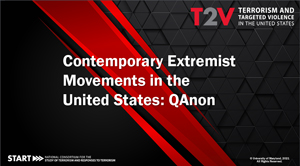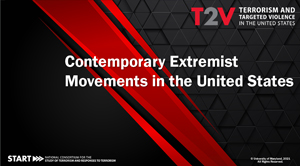START’s collection of Terrorism and Targeted Violence Microlearning Lessons is comprised of two series of short (less than 10 minutes), interactive lessons designed to improve learners’ knowledge of terrorism and targeted violence (T2V) in the United States.
The first series explores the general background on terrorism and targeted violence by examining the tactics and targets of terrorism in the United States.
The second series explores contemporary extremism movements in the United States in terms of ideological movements, with each successive lesson examining a specific contemporary extremist movement.
To learn more, please see our Terrorism and Targeted Violence in the United States project.
Currently Available:
Tactics and Targets in the United States |
|
|
|
Terrorism in the United States: Tactics and Targets provides basic definitions of terrorism, tactics, and targets in the context of terrorist attacks in the United States. This microlearning also provides a brief introduction to patterns of terrorism over the past 50 years. By exploring patterns in terrorist tactics, including attack types and weapons used, as well as an overview of targets, including target/victim types, learners are able to gain useful context for terrorism in the United States. |
Extremist Movements in the United States |
|
|
|
Contemporary Extremist Movements in the United States explores how best to understand extremism in terms of ideological movements. The contemporary nature of extremism in the United States requires that we think about extremism in terms of movements, rather than as a few ideological categories, or exclusively as specific organizations. This microlearning provides important context for the movement specific microlearning lessons that follow. |
 |
Contemporary Extremist Movements in the United States: QAnon provides an assessment of the threat posed by followers of the QAnon conspiracy theory. To better understand the true nature of the QAnon threat, this microlearning explores the characteristics of QAnon offenders and their crimes, including the prevalence of violence in QAnon-inspired criminal acts, and the demographic, radicalization, and group affiliation characteristics of their offenders. |

.jpg)
